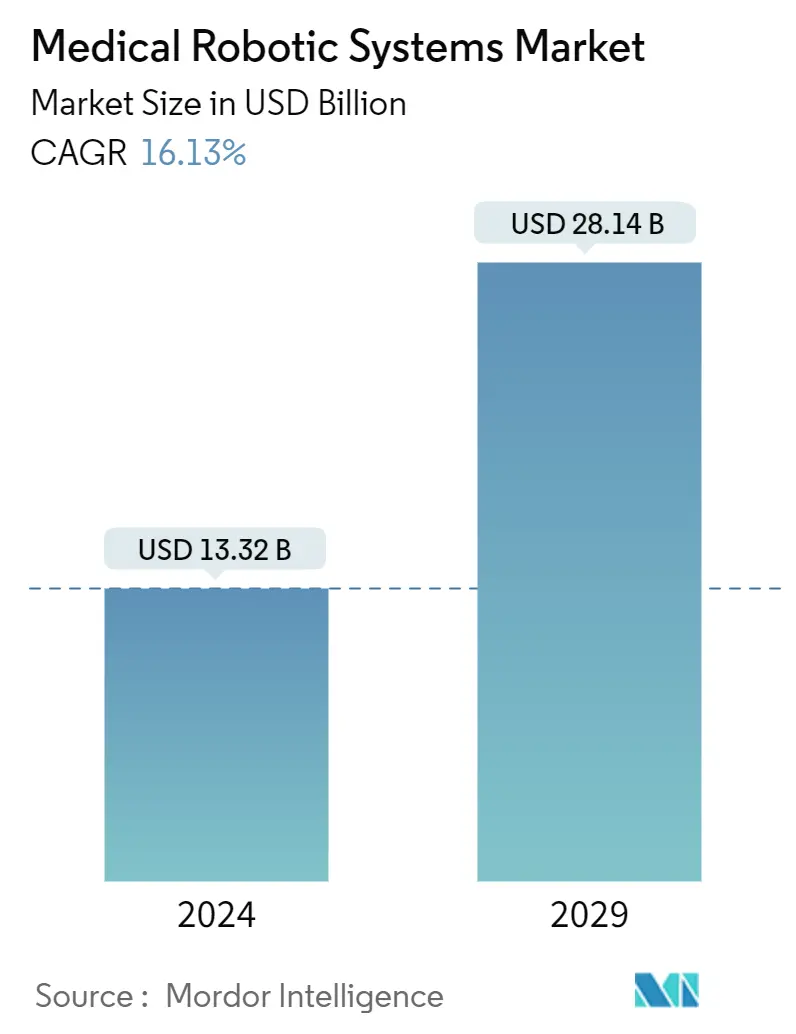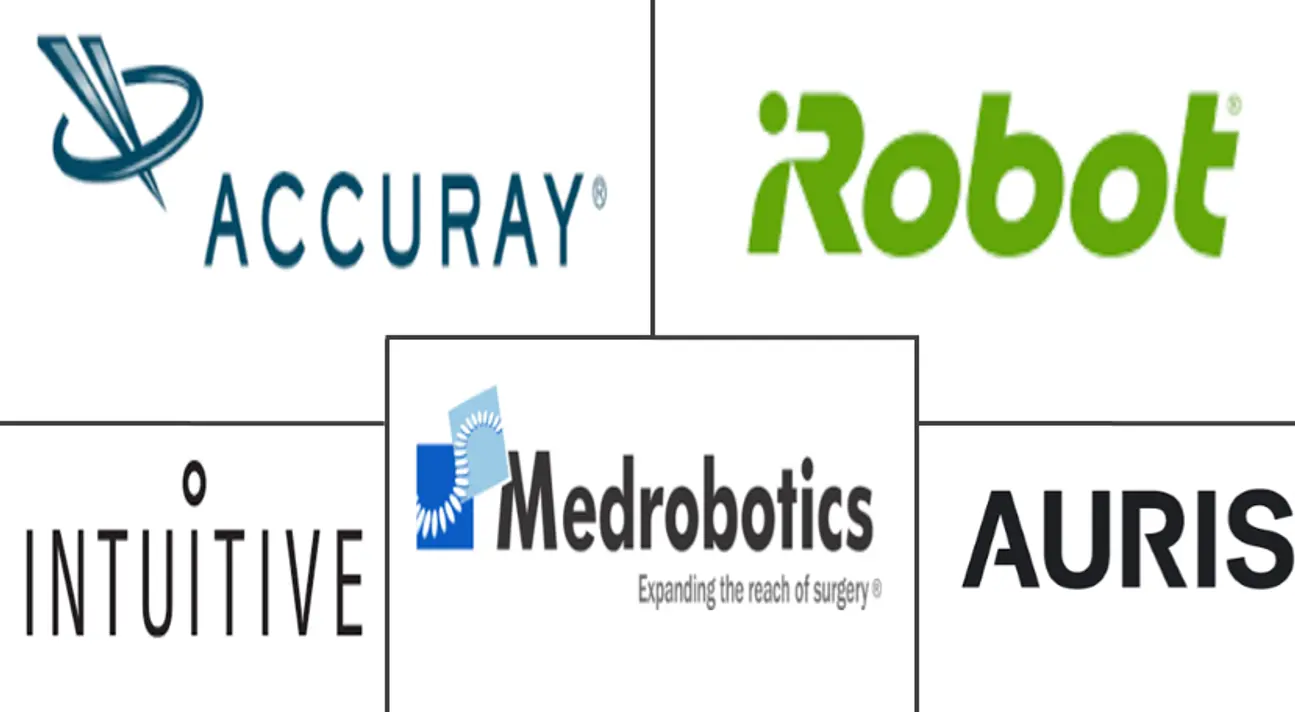Market Size of Medical Robotic Systems Industry

| Study Period | 2019 - 2029 |
| Market Size (2024) | USD 13.32 Billion |
| Market Size (2029) | USD 28.14 Billion |
| CAGR (2024 - 2029) | 16.13 % |
| Fastest Growing Market | Asia Pacific |
| Largest Market | North America |
Major Players
*Disclaimer: Major Players sorted in no particular order |
Medical Robotic Systems Market Analysis
The Medical Robotic Systems Market size is estimated at USD 13.32 billion in 2024, and is expected to reach USD 28.14 billion by 2029, growing at a CAGR of 16.13% during the forecast period (2024-2029).
The public's perception of medical robots in senior living facilities has improved over the last few years. One of the key initiatives that could lower the number of ER visits brought on by accidental falls and increase the accessibility and affordability of at-home care is the implementation of robotic care.
With the rising number of surgical procedures in the geriatric population and mounting cases of trauma injuries, the demand for accurate and proper laparoscopic surgeries and medical procedure solutions has been increasing. As a result, robot-assisted surgery has quickly expanded due to growing opportunities for minimally invasive surgery across the surgical domains. As robotic surgery approaches a decade of commercial use, the market is diversifying, and novel surgical modalities with the new technology decreased costs, and smaller sizes are becoming available.
For instance, medical robots have also increased for intervention and diagnostic purposes. Recent years have also witnessed the application area of robotics and automation solutions extending to medical/pharmaceutical research laboratories, where they are increasingly being used to automate manual, repetitive, and high-volume tasks so scientists and technicians can focus their attention on more strategic tasks to ensure discoveries happen faster.
For a significant period, intuitive surgical procedures have dominated the robotic surgical market and maintained a considerable market share. With original da Vinci patents expiring, the stage is set for an exponential increase in automatic system development. The newer systems seek to improve the da Vinci model through three main avenues: novel technology, reduced cost, and size reduction.
Furthermore, US and European hospitals have rapidly adopted robotic surgery to treat various conditions. One of the most widely used clinical robotic surgical systems includes mechanical and camera arms with surgical instruments attached. Examples of robot-assisted procedures include biopsies, removal of cancerous tumors, repairing heart valves, and gastric bypasses.
Despite all these benefits, factors such as a higher adoption cost, a lower awareness, especially in developing regions, and a lack of technical expertise to operate robotic medical systems are among the significant factor challenging the growth of the studied market.
Due to the significant risk that COVID-19 poses to surgeons, various surgical associations developed safety recommendations for these procedures in the present pandemic. Robots can be included in different parts of the sequence that each surgical patient travels through during their hospital stay to successfully prevent the spread of pathogens. As a result of the greater exposure the pandemic has provided and the benefits these systems offer, the adoption of robotic medical systems is anticipated to grow further during the forecast period.
Medical Robotic Systems Industry Segmentation
Medical robotic systems are fully or partially autonomous robots designed to assist medical personnel and facilities with surgeries, and hospital logistics, enhance patient care, and streamline clinical workflow and workplace safety.
The Medical Robotic Systems Market is segmented by Product Type (Surgical Robotic Systems, Rehabilitative Robotic Systems, Non-invasive Radiosurgery Robots, Hospital, and Pharmacy Robotic Systems) and Geography. The report offers the market size in value terms in USD for all the abovementioned segments.
| By Product Type | |
| Surgical Robotic Systems | |
| Rehabilitative Robotic Systems | |
| Non-invasive Radiosurgery Robots | |
| Hospital and Pharmacy Robotic Systems | |
| Other Robotic Systems |
| By Geography | |||||||
| |||||||
| |||||||
| |||||||
|
Medical Robotic Systems Market Size Summary
The medical robots market is experiencing significant growth, driven by advancements in robotic surgical systems and increasing demand for minimally invasive procedures. The market is expanding as robotic surgery becomes more prevalent in various medical fields, including oncology, urology, and cardiology. The adoption of robotic systems in hospitals, particularly in the US and Europe, is on the rise, with these systems being used for complex procedures such as biopsies and tumor removals. The market is also seeing diversification with the introduction of novel technologies that offer reduced costs and smaller sizes, enhancing the appeal of robotic surgery. Despite the benefits, challenges such as high adoption costs and limited awareness in developing regions continue to pose obstacles to market growth.
In the Asia-Pacific region, particularly China, the demand for medical robots is rapidly increasing, supported by government initiatives and investments in technological advancements. The region's market potential is bolstered by the growing need for advanced healthcare infrastructure and the adoption of instrument-based services. Chinese manufacturers are actively developing innovative robotic solutions, with government backing to reduce reliance on foreign technology. The competitive landscape of the medical robotics market is characterized by strategic collaborations and partnerships among key players, aiming to enhance market share and profitability. These developments, coupled with ongoing research and development efforts, are expected to drive the market's expansion in the coming years.
Medical Robotic Systems Market Size - Table of Contents
-
1. MARKET INSIGHTS
-
1.1 Market Overview
-
1.2 Industry Value Chain Analysis
-
1.3 Industry Attractiveness - Porter's Five Forces Analysis
-
1.3.1 Bargaining Power of Suppliers
-
1.3.2 Bargaining Power of Consumers
-
1.3.3 Threat of New Entrants
-
1.3.4 Threat of Substitute Products
-
1.3.5 Intensity of Competitive Rivalry
-
-
1.4 Assessment of the Impact of COVID-19 on the Market
-
-
2. MARKET SEGMENTATION
-
2.1 By Product Type
-
2.1.1 Surgical Robotic Systems
-
2.1.2 Rehabilitative Robotic Systems
-
2.1.3 Non-invasive Radiosurgery Robots
-
2.1.4 Hospital and Pharmacy Robotic Systems
-
2.1.5 Other Robotic Systems
-
-
2.2 By Geography
-
2.2.1 North America
-
2.2.1.1 United States
-
2.2.1.2 Canada
-
-
2.2.2 Europe
-
2.2.2.1 Germany
-
2.2.2.2 United Kingdom
-
2.2.2.3 France
-
2.2.2.4 Rest of Europe
-
-
2.2.3 Asia Pacific
-
2.2.3.1 China
-
2.2.3.2 Japan
-
2.2.3.3 India
-
2.2.3.4 South Korea
-
2.2.3.5 Rest of Asia Pacific
-
-
2.2.4 Rest of the World
-
2.2.4.1 Latin America
-
2.2.4.2 Middle East and Africa
-
-
-
Medical Robotic Systems Market Size FAQs
How big is the Medical Robotic Systems Market?
The Medical Robotic Systems Market size is expected to reach USD 13.32 billion in 2024 and grow at a CAGR of 16.13% to reach USD 28.14 billion by 2029.
What is the current Medical Robotic Systems Market size?
In 2024, the Medical Robotic Systems Market size is expected to reach USD 13.32 billion.

